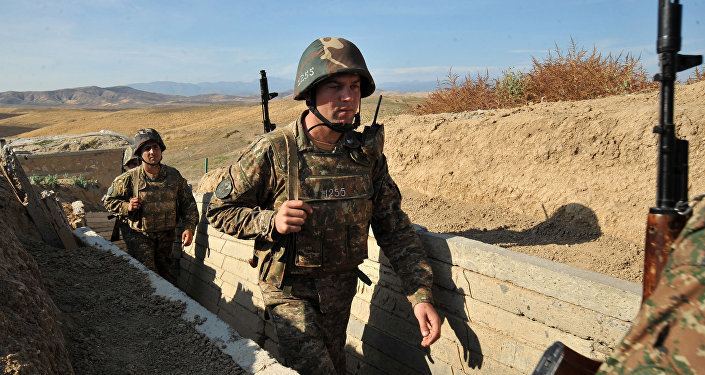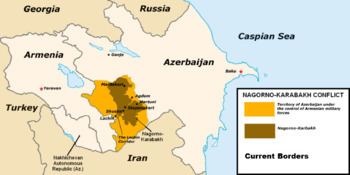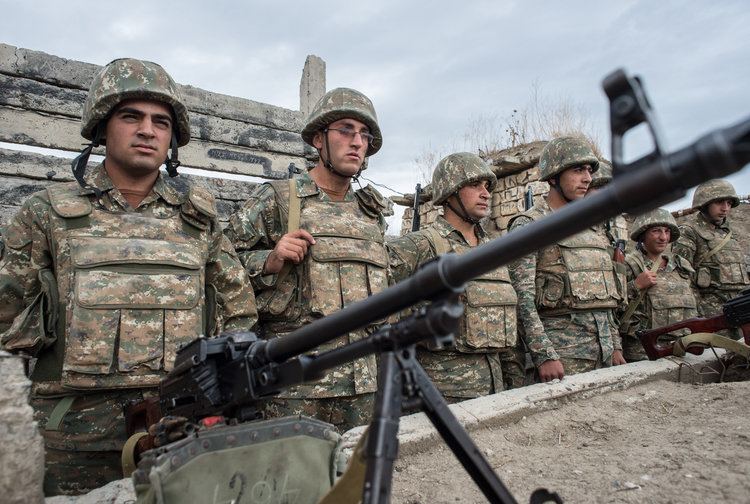 | ||
214 soldiers, 16 civilians killed (2008–2016) 1,008 soldiers and 90+ civilians killed, 1,205 soldiers and 140 civilians wounded, 30+ soldiers and 12 civilians captured (1994–2016) Similar Nagorno‑Karabakh War, Armenian Genocide, Chechen–Russian conflict, Abkhaz–Georgian conflict, Transnistria War | ||
Origins of the nagorno karabakh conflict
The Nagorno-Karabakh conflict is a territorial and ethnic conflict between Armenia and Azerbaijan over the disputed region of Nagorno-Karabakh and seven surrounding districts, which are de facto controlled by the self-declared Nagorno-Karabakh Republic, but are internationally recognized as part of Azerbaijan. The conflict has its origins in the early 20th century, when predominantly Armenian-populated and historically Armenian Nagorno-Karabakh region was incorporated into Soviet Azerbaijan by the decision of Joseph Stalin. The present conflict began in 1988 when the Karabakh Armenians demanded that Karabakh is transferred from Soviet Azerbaijan to Soviet Armenia. The conflict escalated into a full-scale war in the early 1990s. Sporadic tensions and border skirmishes have continued in the region despite an official cease-fire signed in 1994.
Contents
- Origins of the nagorno karabakh conflict
- Nagorno karabakh conflicts footage claiming to show armenian forces firing artillery
- Background
- Nagorno Karabakh War 198894
- 2008 Mardakert skirmishes
- 2010 violence
- 20112013 continued fighting
- 2014 clashes and helicopter shootdown
- 2015 sporadic fighting
- 2016 clashes
- Fatalities
- References

Nagorno karabakh conflicts footage claiming to show armenian forces firing artillery
Background

With Perestroika and the upcoming dissolution of the Soviet Union, ethnic tensions between Armenians in Azerbaijanis increased in the Nagorno-Karabakh region.
Nagorno-Karabakh War (1988–94)

The Nagorno-Karabakh War, also known as the Artsakh Liberation War in Armenia and Nagorno-Karabakh, was an armed conflict that took place in the late 1980s to May 1994, in the enclave of Nagorno-Karabakh in southwestern Azerbaijan, between the majority ethnic Armenians of Nagorno-Karabakh backed by the Republic of Armenia, and the Republic of Azerbaijan. As the war progressed, Armenia and Azerbaijan, both former Soviet Republics, entangled themselves in a protracted, undeclared war in the mountainous heights of Karabakh as Azerbaijan attempted to curb the secessionist movement in Nagorno-Karabakh. The enclave's parliament had voted in favor of uniting itself with Armenia and a referendum, boycotted by the Azerbaijani population of Nagorno-Karabakh, was held, whereby most of the voters voted in favor of independence. The demand to unify with Armenia, which began anew in 1988, began in a relatively peaceful manner; however, in the following months, as the Soviet Union's disintegration neared, it gradually grew into an increasingly violent conflict between ethnic Armenians and ethnic Azerbaijanis, resulting in claims of ethnic cleansing by both sides.

Inter-ethnic clashes between the two broke out shortly after the parliament of the Nagorno-Karabakh Autonomous Oblast (NKAO) in Azerbaijan voted to unify the region with Armenia on 20 February 1988. The circumstances of the dissolution of the Soviet Union facilitated an Armenian separatist movement in Soviet Azerbaijan. The declaration of secession from Azerbaijan was the final result of a territorial conflict regarding the land. As Azerbaijan declared its independence from the Soviet Union and removed the powers held by the enclave's government, the Armenian majority voted to secede from Azerbaijan and in the process proclaimed the unrecognized Republic of Nagorno-Karabakh.

Full-scale fighting erupted in the late winter of 1992. International mediation by several groups including the Organization for Security and Co-operation in Europe (OSCE) failed to bring an end resolution that both sides could work with. In the spring of 1993, Armenian forces captured regions outside the enclave itself, threatening the involvement of other countries in the region. By the end of the war in 1994, the Armenians were in full control of most of the enclave and also held and currently control approximately 9% of Azerbaijan's territory outside the enclave. As many as 230,000 Armenians from Azerbaijan and 800,000 Azerbaijanis from Armenia and Karabakh have been displaced as a result of the conflict. A Russian-brokered ceasefire was signed in May 1994 and peace talks, mediated by the OSCE Minsk Group, have been held ever since by Armenia and Azerbaijan.
Some clashes occurred in the years following the 1994 ceasefire.
2008 Mardakert skirmishes
The 2008 Mardakert skirmishes began on 4 March after the 2008 Armenian election protests. It involved the heaviest fighting between ethnic Armenian and Azerbaijani forces over the disputed region of Nagorno-Karabakh since the 1994 ceasefire after the Nagorno-Karabakh War.
Armenian sources accused Azerbaijan of trying to take advantage of ongoing unrest in Armenia. Azerbaijani sources blamed Armenia, claiming that the Armenian government was trying to divert attention from internal tensions in Armenia.
Following the incident, on March 14 the United Nations General Assembly by a recorded vote of 39 in favour to 7 against adopted Resolution 62/243, demanding the immediate withdrawal of all Armenian forces from the occupied territories of Azerbaijan.
2010 violence
The February 2010 Nagorno-Karabakh skirmish was a scattered exchange of gunfire that took place on February 18 on the line of contact dividing Azerbaijani and the Karabakh Armenian military forces. Azerbaijan accused the Armenian forces of firing on the Azerbaijani positions near Tap Qaraqoyunlu, Qızıloba, Qapanlı, Yusifcanlı and Cavahirli villages, as well as in uplands of Agdam Rayon with small arms fire including snipers. As a result, three Azerbaijani soldiers were killed and one wounded.
The 2010 Mardakert skirmishes were a series of violations of the Nagorno-Karabakh War ceasefire. They took place across the line of contact dividing Azerbaijan and the ethnic Armenian military forces of the unrecognized but de facto independent Nagorno-Karabakh Republic. Both sides accused the other of violating the ceasefire regime. These were the worst violations of the cease fire (which has been in place since 1994) in two years and left Armenian forces with the heaviest casualties since the Mardakert skirmishes of March 2008.
Between 2008 and 2010, 74 soldiers were killed on both sides.
2011–2013 continued fighting
On 10 March 2011, a 10-year-old Azerbaijani boy was killed by Armenian sniper fire.
In late April 2011, border clashes left three Nagorno-Karabakh soldiers dead, while on 5 October, two Azerbaijani and one Armenian soldier were killed. In all during the year, 10 Armenian soldiers were killed.
The following year, border clashes between the armed forces of Armenia and Azerbaijan took place from late April through early June. The clashes resulted in the deaths of five Azerbaijani and four Armenian soldiers. In all during 2012, 19 Azerbaijani and 14 Armenian soldiers were killed. Another report put the number of Azerbaijani dead at 20.
Throughout 2013, 12 Azerbaijani and 7 Armenian soldiers were killed in border clashes.
2014 clashes and helicopter shootdown
In 2014, several border clashes erupted that had resulted in 16 fatalities on both sides by 20 June.
On 2 August, Azerbaijani authorities announced that eight of their soldiers had been killed in three days of clashes with NKO forces, the biggest single death toll for the country's military since the 1994 war. NKO denied any casualties on their side, while saying the Azerbaijanis had suffered 14 dead and many more injured. Local officials in Nagorno-Karabakh reported at least two Armenian military deaths in what was the largest incident in the area since 2008. Five more Azerbaijani troops were killed the following night, bringing the death toll from the August clashes to at least 15. The violence prompted Russia to issue a strong statement, warning both sides not to escalate the situation further.
By August 5, 2014 the fighting that started on 27 July had left 14 Azerbaijani and 5 Armenian soldiers dead. Overall, 27 Azerbaijani soldiers had died since the start of the year in border clashes.
In a separate incident in July 2014, the NKR Defense Army announced that troops had killed one and arrested two members of an Azerbaijani subversive group that had penetrated the contact line. In addition to spying on Armenian troop movements and military installations and civilian settlements in Karvachar (Kelbajar), the team was charged with the murder of Smbat Tsakanyan, a seventeen-year-old Armenian boy and resident of the village of Jumen. Both surviving members of the group were sentenced to life in prison by an Armenian court. In July 2015, video footage recorded by the team was released to the public and aired on Armenian state television.
On November 12, 2014, the Azerbajani armed forces shot down a Nagorno-Karabakh Defense Army Mil Mi-24 helicopter over Karabakh's Agdam district. Three servicemen were killed in the incident. Armenia’s Defense Ministry stated the aircraft was unarmed and called its downing an "unprecedented provocation". Azerbaijani authorities claimed the helicopter was "trying to attack" Azerbaijani army positions. Armenian authorities stated that Azerbaijan will face "grave consequences". With the crash, 2014 became the deadliest year for Armenian forces since the 1994 ceasefire agreement, with 27 soldiers killed in addition to 34 fatalities on the Azerbaijani side. Six Armenian civilians also died in 2014, while by the end of the year the number of Azerbaijanis killed rose to 39 (37 soldiers and 2 civilians).
2015 sporadic fighting
In 2015, 42 Armenian soldiers and 5 civilians were killed as border clashes continued. In addition, at least 64 Azerbaijani soldiers also died.
Sporadic fighting primarily took place in: January, June, August, September, November and throughout December.
2016 clashes
Throughout January and February 2016, four Armenian and four Azerbaijani soldiers were killed in fighting at the Nagorno-Karabakh border. The first casualty of 2016 was a Nagorno-Karabakh soldier Aramayis Voskanian, who was killed by Azerbaijani sniper fire while serving in the eastern direction of the Line of Contact. In mid-February, Hakob Hambartsumyan, an Armenian herdsman from Vazgenashen, was killed by an Azerbaijani sniper. In March, two Azerbaijani and one Armenian soldier were killed in clashes along the border between Azerbaijan and Armenia.
Between 1 and 5 April 2016, heavy fighting along the Nagorno-Karabakh frontline left 88 Armenian and 31–92 Azerbaijani soldiers dead. One Armenian and three Azerbaijani soldiers were also missing. In addition, 10 civilians (six Azerbaijani and four Armenian) were also killed. During the clashes, an Azerbaijani military helicopter, 13 unmanned drones were shot down and an Azerbaijani tank was destroyed.
Between 8 and 17 May 2016, sporadic fighting left 14 Armenian and three Azerbaijani soldiers dead, as well as one Azerbaijani civilian. On 5 October 2016, Armenia artillery shelled Azerbaijani positsions on the line of contact with one Azerbaijani soldier being killed. One Armenian soldier was killed on 11 October 2016 in a skirmish on the line of contact. On 15 November, an Azerbaijani soldier was killed on the line of contact. On 27 November, Azerbaijani forces reported shooting down an Armenian drone which had crossed the line of contact.
Fatalities
Although no exact casualty figures exist, by 2009, as many as 3,000 people, mostly soldiers, had been killed, according to most observers. In 2008, the fighting became more intense and frequent. With 72 deaths recorded throughout the year, 2014 became the bloodiest since the war ended. According to the Union of Relatives of the Artsakh War Missing in Action Soldiers, as of 2014, 239 Karabakhi soldiers remain officially listed as unaccounted for. Between 1 and 5 April 2016, heavy fighting along the Nagorno-Karabakh frontline left 27 Armenian and 28 Azerbaijani soldiers dead. 26 Armenian soldiers were also missing. In addition, six civilians (four Armenian and two Azerbaijani) were killed.
